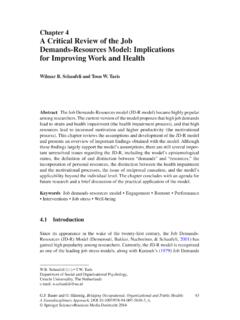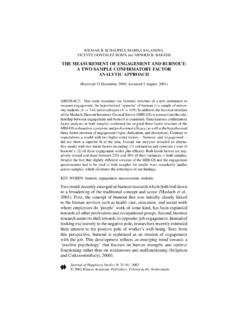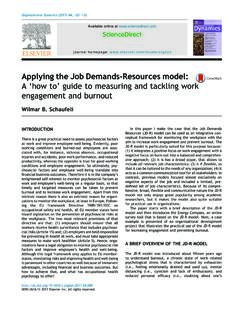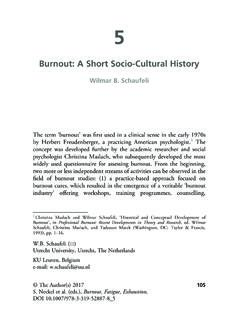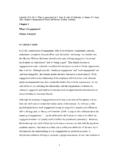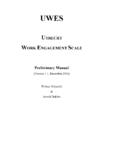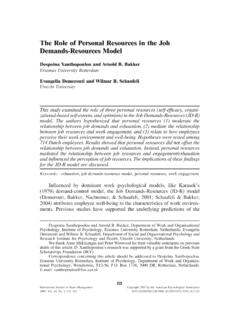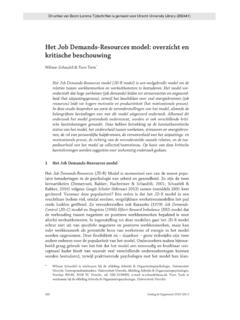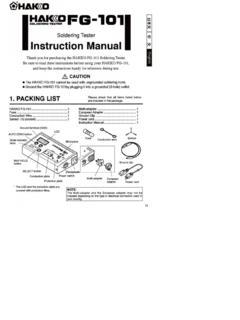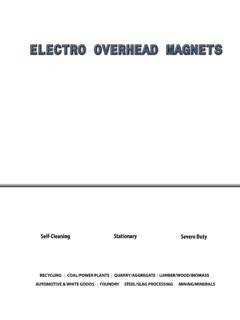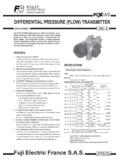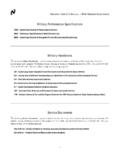Transcription of Educational and Psychological Measurement …
1 Educational Schaufeli et al. and/ Psychological Measurement ofMeasurement W ork Engagement Educational and Psychological Measurement Volume 66 Number 4. August 2006 701-716. The Measurement of 2006 Sage Publications Work Engagement With a hosted at Short Questionnaire A Cross-National Study Wilmar B. Schaufeli Arnold B. Bakker Utrecht University Marisa Salanova Jaume I University This article reports on the development of a short questionnaire to measure work engagement a positive work-related state of fulfillment that is characterized by vigor, dedication, and absorption. Data were collected in 10 different countries (N = 14,521), and results indicated that the original 17-item Utrecht Work Engagement Scale (UWES). can be shortened to 9 items (UWES-9). The factorial validity of the UWES-9 was demon- strated using confirmatory factor analyses, and the three scale scores have good internal consistency and test-retest reliability.
2 Furthermore, a two-factor model with a reduced Burnout factor (including exhaustion and cynicism) and an expanded Engagement factor (including vigor, dedication, absorption, and professional efficacy) fit best to the data. These results confirm that work engagement may be conceived as the positive antipode of burnout. It is concluded that the UWES-9 scores has acceptable psychometric properties and that the instrument can be used in studies on positive organizational behavior. Keywords: work engagement; Measurement ; burnout; Utrecht Work Engagement Scale (UWES). S ince the beginning of this century, increased attention has been paid to what has been coined positive psychology: the scientific study of human strength and opti- mal functioning (Seligman & Csikszentmihalyi, 2000). This approach is considered Authors' Note: The authors express their gratitude to the following colleagues who have provided data (in alphabetical order): Sarah Jane Cotton (Australia), Edgar Bres (Spain), Jan de Jonge (Netherlands), Maureen Dollard (Australia), Martin Euwema (Netherlands), Esther Greenglass (Canada), Asbj rn Grimsmo (Norway), Gabriele Haeslich (Germany), Jari Hakanen (Finland), Sandrine Hollet (France), Saar Langelaan (Netherlands), Pascale Le Blanc (Netherlands), Susana Llorens (Spain), Stig Berge Matthiesen (Norway), Maria Peeters (Netherlands), Astrid Richardsen (Norway), Peter Richter (Germany), Ian Roth- mann (South Africa), Katariina Salmela-Aro (Finland), Sabine Sonnentag (Germany), Willem van 701.
3 702 Educational and Psychological Measurement to supplement the traditional focus of psychology on disease, damage, disorder, and disability. The recent trend to concentrate on optimal functioning also has aroused attention in organizational psychology, as illustrated by Luthans's (2002) recent plea for the study of positively oriented human resource strengths and Psychological capacities that can be measured, developed, and effectively managed for performance improvement in today's workplace (p. 698). One of these positive states is work engagement, which is considered to be the anti- pode of burnout. The current article is about the development and psychometric evalu- ation of a short self-report questionnaire to measure work engagement. Contrary to those who suffer from burnout, engaged employees have a sense of energetic and effective connection with their work activities, and they see themselves as able to deal well with the demands of their jobs.
4 Work engagement is defined as a positive, fulfill- ing work-related state of mind that is characterized by vigor, dedication, and absorp- tion (Schaufeli & Salanova, in press; Schaufeli, Salanova, Gonzalez-Rom , & Bakker, 2002). Rather than a momentary and specific state, engagement refers to a more persistent and pervasive affective-cognitive state that is not focused on any particular object, event, individual, or behavior. Vigor is characterized by high levels of energy and mental resilience while working, the willingness to invest effort in one's work, and persistence even in the face of difficulties. Dedication refers to being strongly in- volved in one's work and experiencing a sense of significance, enthusiasm, inspira- tion, pride, and challenge. Finally, absorption is characterized by being fully concen- trated and happily engrossed in one's work, whereby time passes quickly and one has difficulties with detaching oneself from work.
5 Accordingly, vigor and dedication are considered direct opposites of the core burnout dimensions of exhaustion and cyni- cism, respectively (Maslach, Schaufeli, & Leiter, 2001). Therefore, particularly the correlations between vigor and exhaustion and between dedication and cynicism are expected to be strongly negative. The remaining dimensions of burnout ( , profes- sional efficacy) and of work engagement ( , absorption) are distinct aspects that are not considered as opposites. Based on the above-mentioned definition, a self-report questionnaire the Utrecht Work Engagement Scale (UWES) has been developed that includes the three consti- tuting dimensions of work engagement: vigor, dedication, and absorption. Originally, the UWES included 24 items, but after psychometric evaluation, 7 unsound items were eliminated so that three scales, totaling 17 items, remained (Schaufeli, Salanova, et al.)
6 , 2002): Vigor (VI, 6 items), Dedication (DE, 5 items), and Absorption (AB, 6. items) scales (see the appendix). Using a large international database, the current arti- cle seeks to reduce the number of items of the UWES. The reason for shortening the UWES is basically pragmatic: Researchers strive to include as few items as possible Rhenen (Netherlands), Toon Taris (Netherlands), Peter Vlerick (Belgium), Tony Winefield (Australia), Hans de Witte (Belgium), and Dieter Zapf (Germany). Please address correspondence to Wilmar B. Schaufeli, PhD, Utrecht University, Department of Psychology, Box 80140, 3508 TC Utrecht, the Netherlands. Schaufeli et al. / Measurement of Work Engagement 703. for measuring a particular construct because respondents should not be unnecessarily bothered. Besides, long questionnaires increase the likelihood of attrition. The original UWES-17 has encouraging psychometric features for its scores.
7 For instance, internal consistencies (Cronbach's alpha) typically range between .80 and .90 (Demerouti, Bakker, Janssen, & Schaufeli, 2001; Dur n, Extremera, & Rey, 2004;. Montgomery, Peeters, Schaufeli, & Den Ouden, 2003; Salanova, Schaufeli, Llorens, Peir , & Grau, 2001; Schaufeli & Bakker, 2004). Thus, values of Cronbach's alpha exceed the value of .70 that is traditionally used as a rule of thumb (Nunnally &. Bernstein, 1994), and even more so, in almost all cases, alpha satisfies the more strin- gent value of .80 that is now considered a generally accepted standard (Henson, 2001). Furthermore, confirmatory factor analyses have shown that the hypothesized three- factor structure of the UWES is superior to the one-factor model (Schaufeli, Mart nez, Marques-Pinto, Salanova, & Bakker, 2002; Schaufeli, Salanova, et al., 2002). How- ever, in contrast, using explorative factor analyses, Sonnentag (2003) did not find a clear three-factor structure and decided to use the total score of the UWES as a mea- sure for work engagement.
8 Furthermore, the three-factor structure of the slightly adapted student version of the UWES is largely invariant across samples from Spain, the Netherlands, and Portugal (Schaufeli, Mart nez, et al., 2002). In a similar vein, the UWES can be used as an unbiased instrument to measure work engagement because its equivalence is acceptable for different racial groups (Storm & Rothmann, 2003). Although confirmatory factor analyses have supported the three-dimensional struc- ture of the UWES, the dimensions are very closely related. That is, correlations between the scales usually exceed .65 ( , Demerouti et al., 2001; Salanova et al., 2001; Schaufeli, Mart nez, et al., 2002; Schaufeli, Salanova, et al., 2002), whereas correlations between latent variables of a covariance structure model range from about .80 to more than .90 (Salanova et al., 2001; Schaufeli, Mart nez, et al.)
9 , 2002;. Schaufeli, Salanova, et al., 2002). Because engagement has been defined as the opposite of burnout (Maslach et al., 2001), it is expected that both concepts are negatively related. Indeed, the three burn- out dimensions as measured with the Maslach Burnout Inventory (MBI; Maslach, Jackson, & Leiter, 1996) correlate negatively with the three dimensions of work engagement (Demerouti et al., 2001; Montgomery et al., 2003; Salanova et al., 2001;. Schaufeli & Bakker, 2004; Schaufeli, Mart nez, et al., 2002; Schaufeli, Salanova, et al., 2002). However, the pattern of relationships slightly differs from what was expected. Namely, the negative correlations between vigor and exhaustion and be- tween dedication and cynicism do not appear to be the strongest but, instead, the corre- lations between lack of professional efficacy and all three aspects of engagement.
10 In the discussion, we will elaborate on this. As a consequence, a second-order factor model, in which the three engagement scales weighted together with professional effi- cacy constitute on one factor (Engagement) and exhaustion and cynicism on the other factor (Burnout), fits best to the data (Salanova et al., 2001; Schaufeli & Bakker, 2004; Schaufeli, Salanova, et al., 2002). A similar result was obtained by Demerouti et al. (2001) using discriminant analyses. In this study, the three engagement scales 704 Educational and Psychological Measurement Table 1. Countries Included in the Database Country n %. 1. Australia 473 2. Belgiuma 767 3. Canada 267 4. Finland 3,651 5. France 221 6. Germany 465 7. The Netherlandsa 2,163 8. Norwaya 2,114 9. South Africa 2,547 10. Spain 1,832 Total 14,521 a. Burnout data are (partly) not available (see text). plus professional efficacy weighted on one discriminant function, whereas both other burnout scales weighted on the second remaining function.

